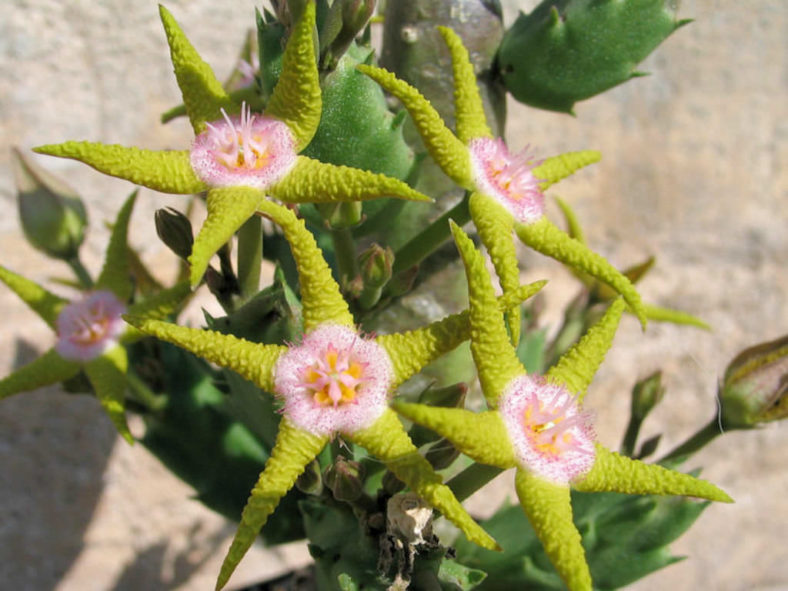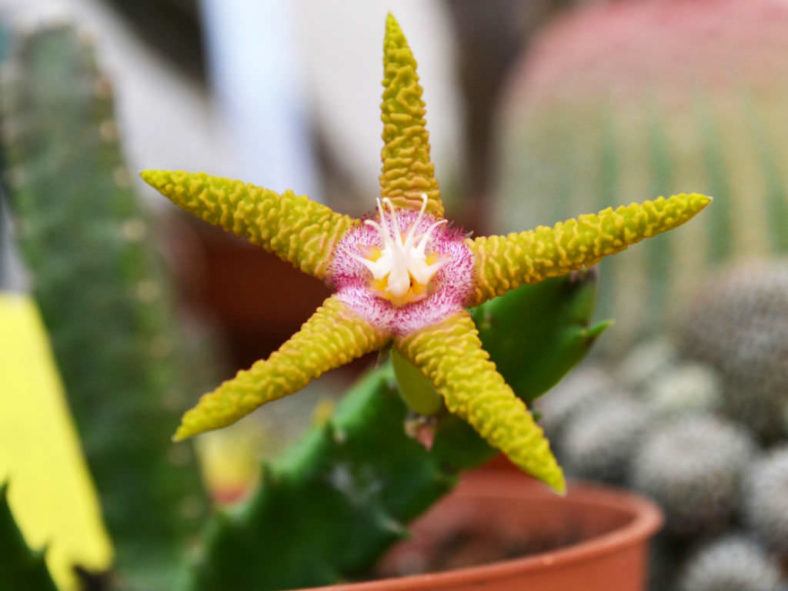Scientific Name
Stapelia flavopurpurea Marloth
Scientific Classification
Family: Apocynaceae
Subfamily: Asclepiadoideae
Tribe: Stapeliae
Genus: Stapelia
Description
Stapelia flavopurpurea is a small succulent that forms a diffuse clump of decumbent stems with inconspicuous tubercles widely spaced along the ribs. The stems are deep green, suffused with purple, and have a somewhat sandpapery texture. They are square in cross-section and can grow up to 4 inches (10 cm) long and 0.6 inches (1.5 cm) thick, with a tendency to taper evenly towards the apex. The tubercles are tipped with a small and very slightly spreading leaf rudiment.
The flowers are sweetly scented and appear near the tips of the stems, often in several small clusters per stem in late summer and fall, held on short erect peduncles facing upwards. They are star-shaped, up to 2 inches (5 cm) across, green, yellow, brown, or pale red on lobes, changing abruptly just below bases to white where they are covered with translucent white to dark purple clavate hairs bright yellow to green with maroon overtones and centers.

Hardiness
USDA hardiness zones 10b to 11b: from 35 °F (+1.7 °C) to 50 °F (+10 °C).
How to Grow and Care
Several species are relatively easy to grow. Others, often those with slightly hairy stems and the more unusual flowers, are more challenging and require careful watering (with some fertilizer) during the growing season and complete water withdrawal during the winter months. A minimum winter temperature of 10°C (50°F) is acceptable, providing plants are kept dry. A heated growing bench or incubator may help delicate plants get through the colder months. However, many species live under shrubs in their habitat and prefer light shade rather than full sun.
A gritty succulent soil mix is essential, and clay pots are advisable for the more delicate species. Some growers prefer mineral-only soil to minimize the chance of a fungal attack on the roots. A layer of grit on the soil's surface prevents moisture from accumulating around the base of stems.
Keeping Stapelias and their roots free of pests such as mealybugs is the real key to success, as fungal attack often occurs due to damage to stems by insects.
Learn more at How to Grow and Care for Stapelia.
Origin
Stapelia flavopurpurea is endemic to Namibia.
Links
- Back to genus Stapelia
- Succupedia: Browse succulents by Scientific Name, Common Name, Genus, Family, USDA Hardiness Zone, Origin, or cacti by Genus
Photo Gallery
Click on a photo to see a larger version.

